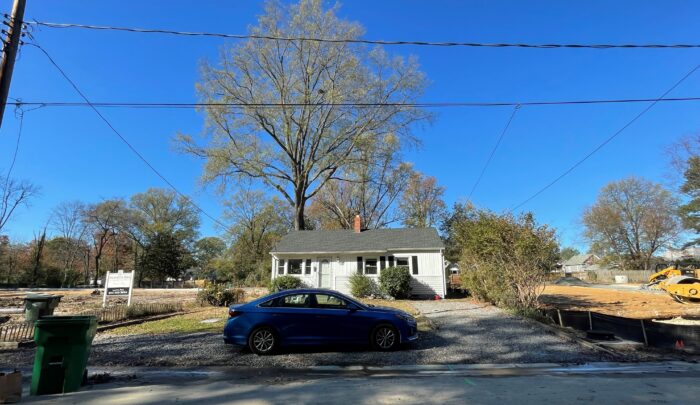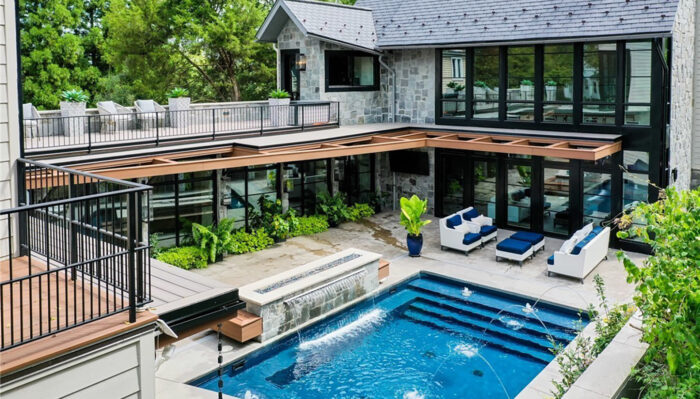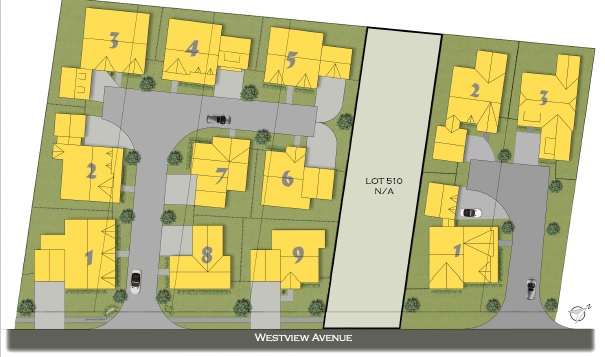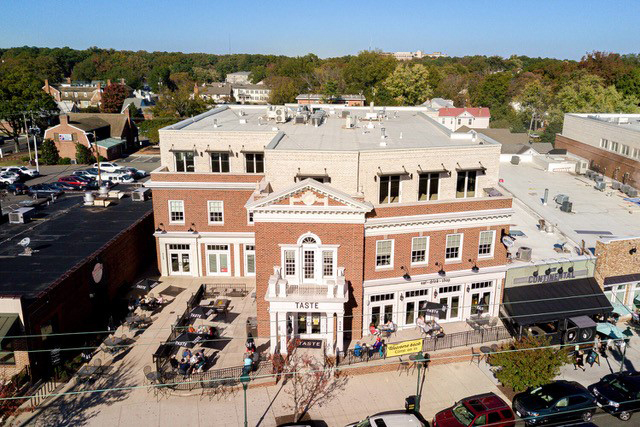
510 Westview Ave. is the last house standing on a portion of the street as site work on new homes surrounds it. (BizSense file photo)
Editor’s note: This is the third in a five-part commentary series from Edwin Slipek on historic preservation issues in various Richmond neighborhoods. Here’s part 1 and part 2.
In the mind’s eye of many locals, the leafy and lively environs of Libbie and Grove avenues is a reassuringly comfortable blend of golf, gastronomy and God. The sprawling greens of the Country Club of Virginia, the selection of high-casual dining eateries and the two architecturally splendid Gothic Revival churches, St. Bridget Catholic and St. Stephen’s Episocopal, create a prep-perfect landscape worthy of a Louis Auchincloss novel.
Dozens of similarly picture-perfect villages grace East Coast communities. In East Hampton on Long Island, New York, the Atlantic Ocean-fronting links of the Maidstone Club, a handful of fine restaurants, and the fortress-like sanctuary of St. Luke’s Episcopal Church are within walking distance of each other. Farther north on Cape Cod, in Hyannis Port, Massachusetts, the golf tees of the Hyannisport Club (the village and club are spelled differently), combined with many freshly-harvested lobster options, and the looming stone tower of St. Andrews by-the-Sea Episcopal Church, exude similar elan.
While many take comfort that architectural and social change occurs slowly in such tony enclaves, in Westhampton look again. A recent windshield survey in the blocks near the Libbie and Grove crossroads suggests that rapid physical and visual change is underway.
At 5605 Grove Ave. on a lot alone valued at $898,000, a century-old farmhouse that housed Kim Faison Antiques for 20 years was recently demolished. In its place an architecturally undistinguished, two story, modern office building will be built on the mostly residential block. Up the street and around the corner at Libbie Avenue near Cary Street Road, a sizable Italianate (or is it French Provincial?) residence is the newcomer on a stretch of well-tended, understated, former bungalows and farmhouses.

113 Libbie Ave. features a courtyard with pool between the main house and guest apartment. (Images courtesy of CVRMLS)
Libbie’s rural lane appeal, however, is jarred by the recently built home at 113 Libbie. This is a 5,000-square-foot structure (of “modern industrial design” according to marketing materials) with an outdoor swimming pool, and a dog run with “a live turf run” for pets, shoe-horned onto its slender site. It is for sale with an asking price of $3.8 million.

A conceptual site plan of the Westview at Libbie layout.
Nearby, while nothing that expensive, new houses being built on the neighboring streets of Maple, Granite and Westview are bringing dramatic change to once-modestly priced addresses. At 325 Granite, on a deep and narrow lot where a modest-sized house was demolished, contractors are completing a swimming pool at the rear of the property so that they can back their way out to the street as construction of the new house proceeds. A block over at 510 Westview, a single mid-20th century tract house is the sole survivor of 10 adjacent houses that are now dust. We can assume that first-time homeowners can’t afford to settle in here.
As the New York Times recently wrote about similar situations changing the face of many neighborhoods nationwide: “All of these scenes are happening in … desirable locations with good jobs and rising home prices. That might mean a little two-bedroom house that once sat on dirt worth $10,000 is now sitting on dirt worth $200,000.”
Historically, according to the Times, land has accounted for 20 percent of the total sales price of a new home: “Today that means a parcel of land worth $200,000 may warrant a new house that sells for a million dollars.”
There is nothing inherently wrong with expensive housing options; it’s great for the local tax base. But the special texture and small-town appeal of Westhampton, with its modest-sized houses sitting in close proximity to a range of commercial activity, upper-priced old homes, and excellent private schools, had created a socio-economic dynamic that was, well, kind of perfect. During the past decade here, demand has intensified to transform early 20th century housing blocks, where working class people could once afford to live, into something grander. It seemed kind of cool that the modest homes were in close proximity to the big houses on Three Chopt Road and Cary Street Road. In many Anglo- and American towns, those choice thoroughfares were often known as “High Street.”
In the 300 block of Maple Avenue in the early 1930s, for instance, there were working class households. Lawrence Mesco was a fireman, James Hubbard was a barber, and Everett Clayton was a baker. A block west on Libbie at that time Robert Detrick lived above his hardware and paint store while Jack Basinger was a blacksmith and Hugh Gentry was a fireman. Neighbors on the street operated a shoe repair shop, the Westhampton Pharmacy, and a billiards parlor, respectively.
During the Great Depression, on the northwest corner of Grove at Libbie, a confectionary shop occupied the building where the Peter Blair haberdashery now operates. By the 1960s this address was a popular watering hole, the Tempo Room. The crossroads gradually became more upscale by the 1970s when Virginia Wortham, an elegant and feisty grande dame, moved her venerable downtown operation, E. B. Taylor, which specialized in fine china and crystal, to 5720 Grove Ave. She rebranded the shop the Hampton House.
And consider the Westhampton cinema. For 80 years until recently, the elegant theater was a Grove Avenue anchor as well as a popular destination for cinephiles. Richmonders felt quite comfortable (despite the uncomfortable seats) in the auditorium decorated with Chinese Chippendale wallpaper. The lobby was a parlor, really. It was furnished in 18th century American antiques and accessories that had been acquired by the theater’s savvy owner, Morton G. Thalhimer, and his wife, Ruth.

The Westhampton on Grove complex that replaced the Westhampton Theater.
But recently, only in the well-heeled West End would a beloved and historic movie palace be demolished and replaced with an expensive, faux-front, mixed-use structure, housing condominiums, whose cloying colonial revival facade recalls the destroyed landmark.
In 1963 President John F. Kennedy famously remarked: “A rising tide lifts all boats.” But this economic aphorism is an exception to the new rules of the prosperous vicinity of Libbie and Grove. Many folks who could once have afforded to live there will be left out as Westhampton’s WASPY local village charm and diversity is lost. So lift your glasses and mugs to the late Tempo Room, and more recently, Phil’s Continental Lounge.
Guest Commentary: The rising tides of Westhampton
510 Westview Ave. is the last house standing on a portion of the street as site work on new homes surrounds it. (BizSense file photo)
Editor’s note: This is the third in a five-part commentary series from Edwin Slipek on historic preservation issues in various Richmond neighborhoods. Here’s part 1 and part 2.
In the mind’s eye of many locals, the leafy and lively environs of Libbie and Grove avenues is a reassuringly comfortable blend of golf, gastronomy and God. The sprawling greens of the Country Club of Virginia, the selection of high-casual dining eateries and the two architecturally splendid Gothic Revival churches, St. Bridget Catholic and St. Stephen’s Episocopal, create a prep-perfect landscape worthy of a Louis Auchincloss novel.
Dozens of similarly picture-perfect villages grace East Coast communities. In East Hampton on Long Island, New York, the Atlantic Ocean-fronting links of the Maidstone Club, a handful of fine restaurants, and the fortress-like sanctuary of St. Luke’s Episcopal Church are within walking distance of each other. Farther north on Cape Cod, in Hyannis Port, Massachusetts, the golf tees of the Hyannisport Club (the village and club are spelled differently), combined with many freshly-harvested lobster options, and the looming stone tower of St. Andrews by-the-Sea Episcopal Church, exude similar elan.
While many take comfort that architectural and social change occurs slowly in such tony enclaves, in Westhampton look again. A recent windshield survey in the blocks near the Libbie and Grove crossroads suggests that rapid physical and visual change is underway.
At 5605 Grove Ave. on a lot alone valued at $898,000, a century-old farmhouse that housed Kim Faison Antiques for 20 years was recently demolished. In its place an architecturally undistinguished, two story, modern office building will be built on the mostly residential block. Up the street and around the corner at Libbie Avenue near Cary Street Road, a sizable Italianate (or is it French Provincial?) residence is the newcomer on a stretch of well-tended, understated, former bungalows and farmhouses.
113 Libbie Ave. features a courtyard with pool between the main house and guest apartment. (Images courtesy of CVRMLS)
Libbie’s rural lane appeal, however, is jarred by the recently built home at 113 Libbie. This is a 5,000-square-foot structure (of “modern industrial design” according to marketing materials) with an outdoor swimming pool, and a dog run with “a live turf run” for pets, shoe-horned onto its slender site. It is for sale with an asking price of $3.8 million.
A conceptual site plan of the Westview at Libbie layout.
Nearby, while nothing that expensive, new houses being built on the neighboring streets of Maple, Granite and Westview are bringing dramatic change to once-modestly priced addresses. At 325 Granite, on a deep and narrow lot where a modest-sized house was demolished, contractors are completing a swimming pool at the rear of the property so that they can back their way out to the street as construction of the new house proceeds. A block over at 510 Westview, a single mid-20th century tract house is the sole survivor of 10 adjacent houses that are now dust. We can assume that first-time homeowners can’t afford to settle in here.
As the New York Times recently wrote about similar situations changing the face of many neighborhoods nationwide: “All of these scenes are happening in … desirable locations with good jobs and rising home prices. That might mean a little two-bedroom house that once sat on dirt worth $10,000 is now sitting on dirt worth $200,000.”
Historically, according to the Times, land has accounted for 20 percent of the total sales price of a new home: “Today that means a parcel of land worth $200,000 may warrant a new house that sells for a million dollars.”
There is nothing inherently wrong with expensive housing options; it’s great for the local tax base. But the special texture and small-town appeal of Westhampton, with its modest-sized houses sitting in close proximity to a range of commercial activity, upper-priced old homes, and excellent private schools, had created a socio-economic dynamic that was, well, kind of perfect. During the past decade here, demand has intensified to transform early 20th century housing blocks, where working class people could once afford to live, into something grander. It seemed kind of cool that the modest homes were in close proximity to the big houses on Three Chopt Road and Cary Street Road. In many Anglo- and American towns, those choice thoroughfares were often known as “High Street.”
In the 300 block of Maple Avenue in the early 1930s, for instance, there were working class households. Lawrence Mesco was a fireman, James Hubbard was a barber, and Everett Clayton was a baker. A block west on Libbie at that time Robert Detrick lived above his hardware and paint store while Jack Basinger was a blacksmith and Hugh Gentry was a fireman. Neighbors on the street operated a shoe repair shop, the Westhampton Pharmacy, and a billiards parlor, respectively.
During the Great Depression, on the northwest corner of Grove at Libbie, a confectionary shop occupied the building where the Peter Blair haberdashery now operates. By the 1960s this address was a popular watering hole, the Tempo Room. The crossroads gradually became more upscale by the 1970s when Virginia Wortham, an elegant and feisty grande dame, moved her venerable downtown operation, E. B. Taylor, which specialized in fine china and crystal, to 5720 Grove Ave. She rebranded the shop the Hampton House.
And consider the Westhampton cinema. For 80 years until recently, the elegant theater was a Grove Avenue anchor as well as a popular destination for cinephiles. Richmonders felt quite comfortable (despite the uncomfortable seats) in the auditorium decorated with Chinese Chippendale wallpaper. The lobby was a parlor, really. It was furnished in 18th century American antiques and accessories that had been acquired by the theater’s savvy owner, Morton G. Thalhimer, and his wife, Ruth.
The Westhampton on Grove complex that replaced the Westhampton Theater.
But recently, only in the well-heeled West End would a beloved and historic movie palace be demolished and replaced with an expensive, faux-front, mixed-use structure, housing condominiums, whose cloying colonial revival facade recalls the destroyed landmark.
In 1963 President John F. Kennedy famously remarked: “A rising tide lifts all boats.” But this economic aphorism is an exception to the new rules of the prosperous vicinity of Libbie and Grove. Many folks who could once have afforded to live there will be left out as Westhampton’s WASPY local village charm and diversity is lost. So lift your glasses and mugs to the late Tempo Room, and more recently, Phil’s Continental Lounge.